Strengthen Your SEO Foundation With Pillar Pages and Topic Clusters
Aug 12, 2024
Written by Casey Bjorkdahl

Casey Bjorkdahl is one of the pioneering thought leaders in the SEO community. In 2010, Casey co-founded Vazoola after working for a Digital Marketing Agency for five years in New York City. Vazoola is now one of the fastest growing and most widely recognized SEO marketing firms in the country.

An effective and powerful SEO foundation is a must for content creators, whether they’re bloggers, business owners, or agencies.
Strengthening your content marketing strategy is key to ensure your audience not only finds your content – they find it invaluable. That’s where pillar pages and content clusters come into play. These two SEO elements form the basis of what we like to call pillar-based marketing.
Stay with us as we guide you through what pillar pages and content clusters are, and we describe how to create a pillar page SEO effectively. Most importantly, we’ll show you how they can revolutionize the ways in which your target audience interacts with your content.
By the end of this article, you’ll have a solid understanding of these concepts, and you’ll be well on your way toward implementing them, thereby boosting SEO and content visibility.
Key Takeaways:
-
Pillar pages and content clusters enhance SEO by organizing content around central topics and linking to related subtopics.
-
Content pillars are foundational themes central to a brand's expertise, while pillar pages provide comprehensive coverage on these topics.
-
Topic clusters revolve around a specific pillar topic and interlink related content, improving both user experience and search visibility.
-
Pillar pages differ from landing pages in that they educate and guide users through content, while landing pages focus on driving conversions.
-
Effective pillar pages should link extensively to related cluster content, signaling to search engines that the page is a comprehensive resource.
Table of Contents:
What Are Content Pillars, SEO Pillar Pages and Topic Clusters?
In our experience at Vazoola, understanding the structure of your website's content can profoundly impact your SEO and the way your audience interacts with published materials. But you’re probably wondering how to create topic clusters, pillar pages and the like.
Stay with us as we examine the concepts of content pillars, pillar pages, and topic clusters – all essential components of an effective SEO strategy.
What Is a Content Pillar?
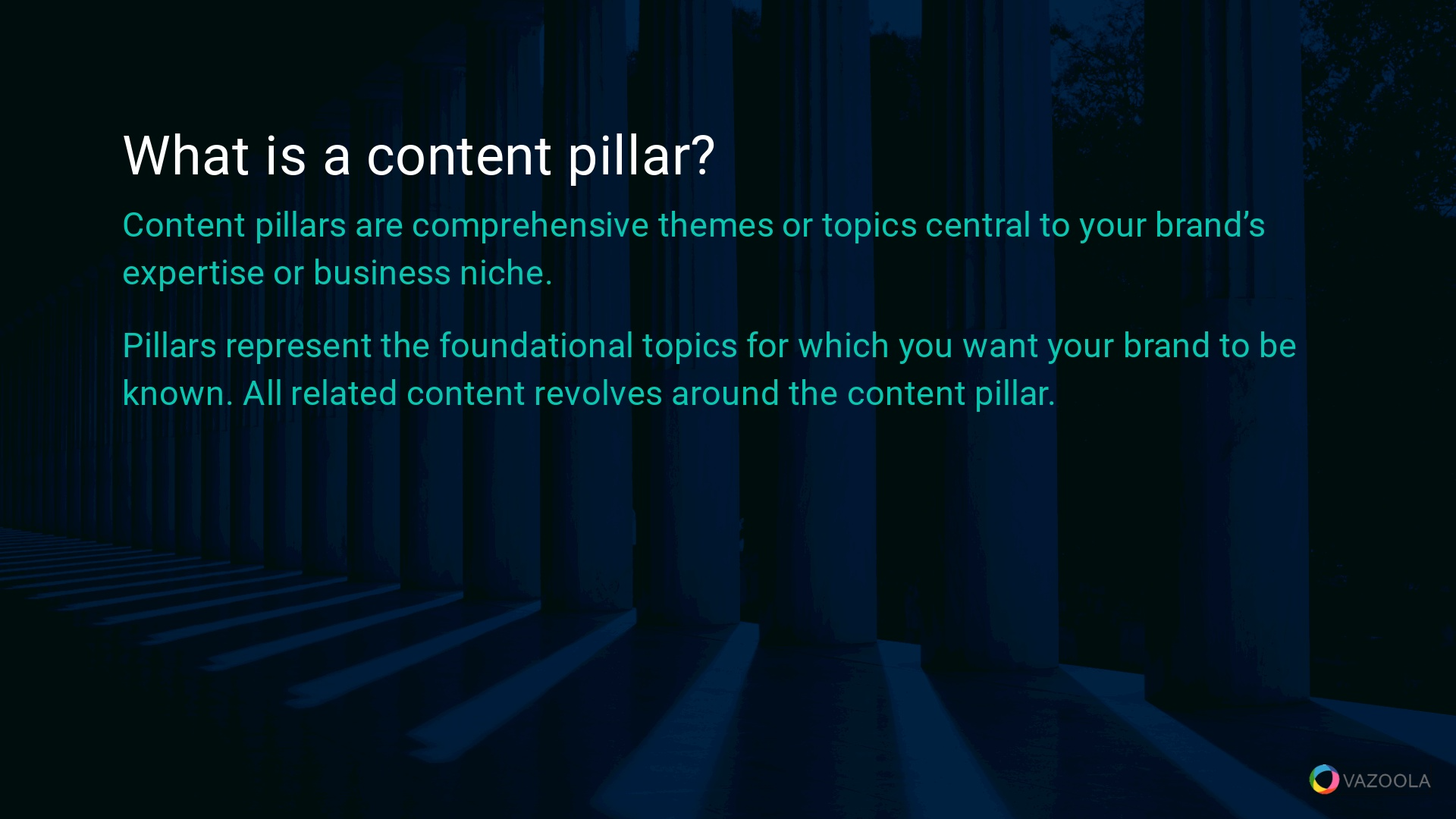
What is a content pillar definition? What is a pillar post?
What is SEO pillar content? Content pillars are comprehensive themes or topics central to your brand’s expertise or business niche. Pillars represent the foundational topics for which you want your brand to be known. All related content then revolves around the content pillars.
What Is a Pillar Page?
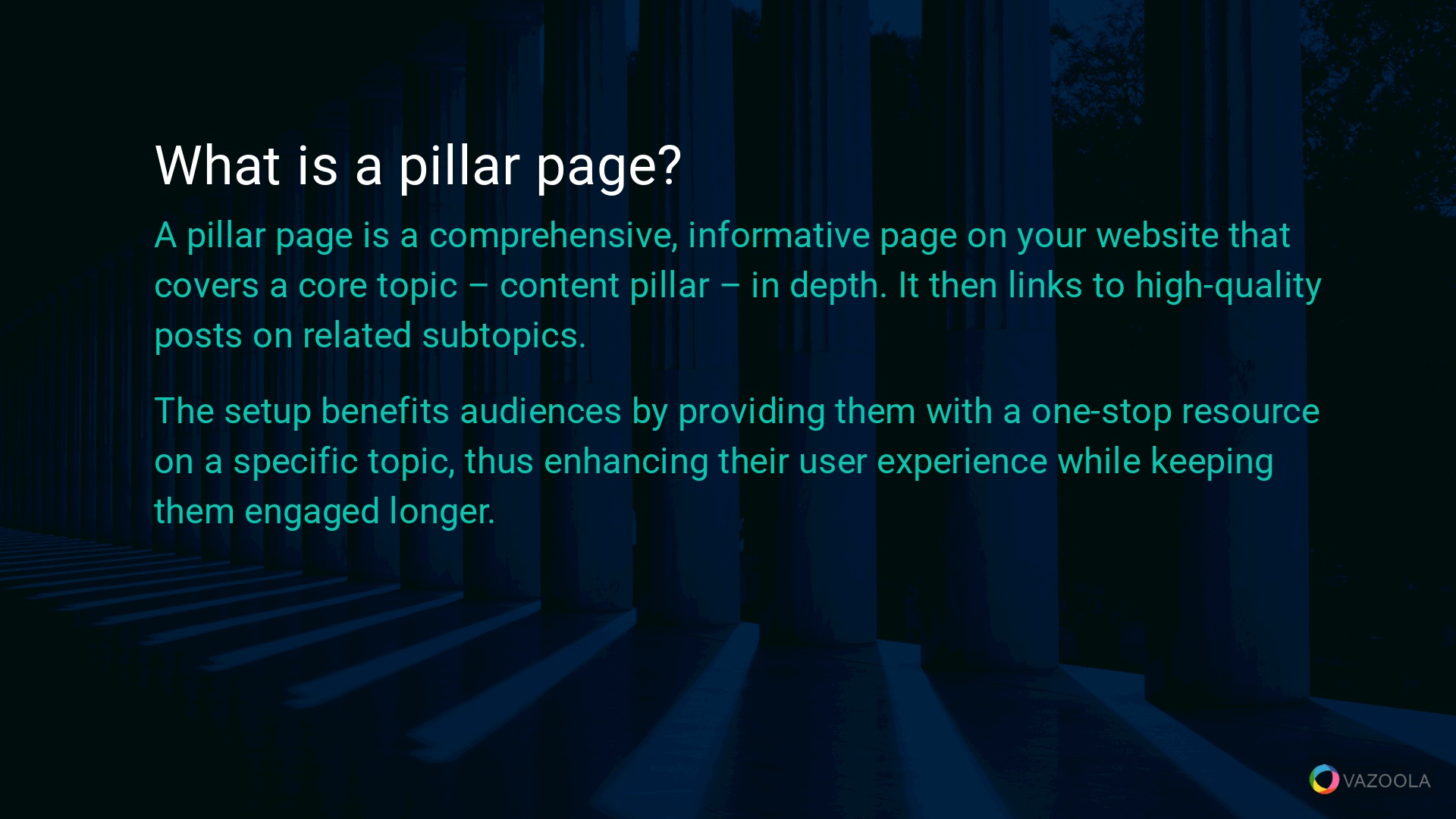
What is an SEO pillar page definition?
A pillar page is a comprehensive, informative page on your website that covers a core topic – content pillar – in depth. It then links to high-quality posts on related subtopics. The setup benefits audiences by providing them with a one-stop resource on a specific topic, thus enhancing their user experience while keeping them engaged longer.
In your digital marketing strategy, SEO pillar pages establish your site’s domain authority. They improve your search rankings by structuring content in a way that's easier for search engines to understand and index.
Pro Tips:
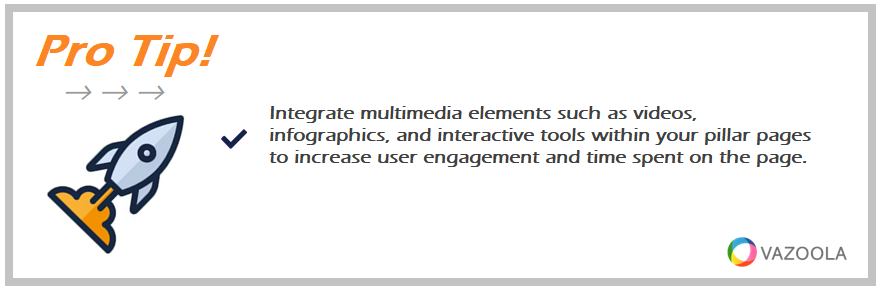
Integrate multimedia elements such as videos, infographics, and interactive tools within your pillar pages to increase user engagement and time spent on the page.
What Are Content Topic Clusters SEO?

What is the content topic clusters definition?
Content topic clusters revolve around a specific pillar topic. Each cluster is a group of interlinked web pages linked to the same pillar page. Topic clusters help organize your site’s content architecture. They also guide visitors seamlessly through related topics, enhancing their learning experiences.
From an SEO perspective, topic cluster strategy boosts the authority of the pillar page and enhances the search visibility of each individual piece within the cluster. The structure directly caters to your target audience’s needs.
Pro Tips:
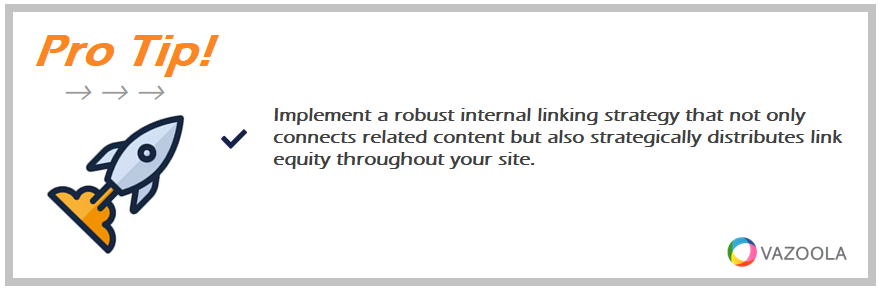
Implement a robust internal linking strategy that not only connects related content but also strategically distributes link equity throughout your site.
Pillar Page vs. Landing Page
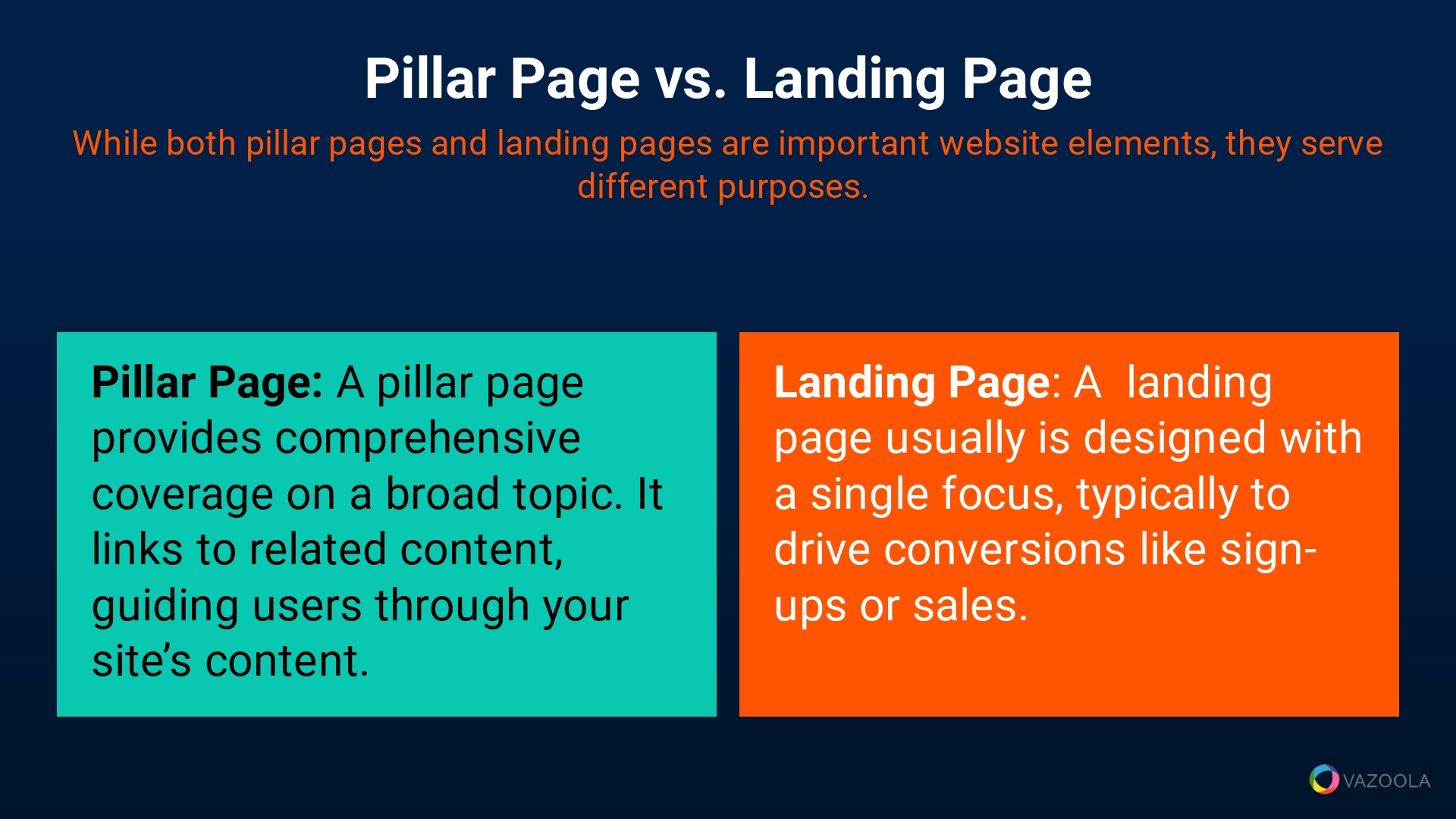
While both pillar pages and landing pages are important website elements, they serve different purposes.
A pillar page provides comprehensive coverage on a broad topic. It links to related content, effectively educating and guiding users through your site’s content.
On the other hand, a landing page usually is designed with a single focus, typically to drive conversions like sign-ups or sales.
The two types of pages share a strategic goal of funneling visitors toward desired actions, whether for educating or converting them. They also share an interdependency since landing pages can be used to direct readers toward pillar pages, enhancing the user’s journey and guiding them down a potential conversion path.
Pillar Page vs. Cornerstone Content

Pillar pages and cornerstone content are similar in that both are meant to offer substantial, authoritative information on key topics. However, the main differences between pillar pages and cornerstone content are the scope and the intention behind them.
Cornerstone content is usually fundamental articles or blog posts that passively attract traffic and convey expertise.
Pillar pages, on the other hand, actively structure and tie together your entire site’s content strategy. They directly link various content pieces and boost SEO through a more organized architecture.
Both types of content support one another, strengthening your site's visibility and authority. Each serve as vital nodes in the broader content marketing strategy.
Types of Pillars Pages
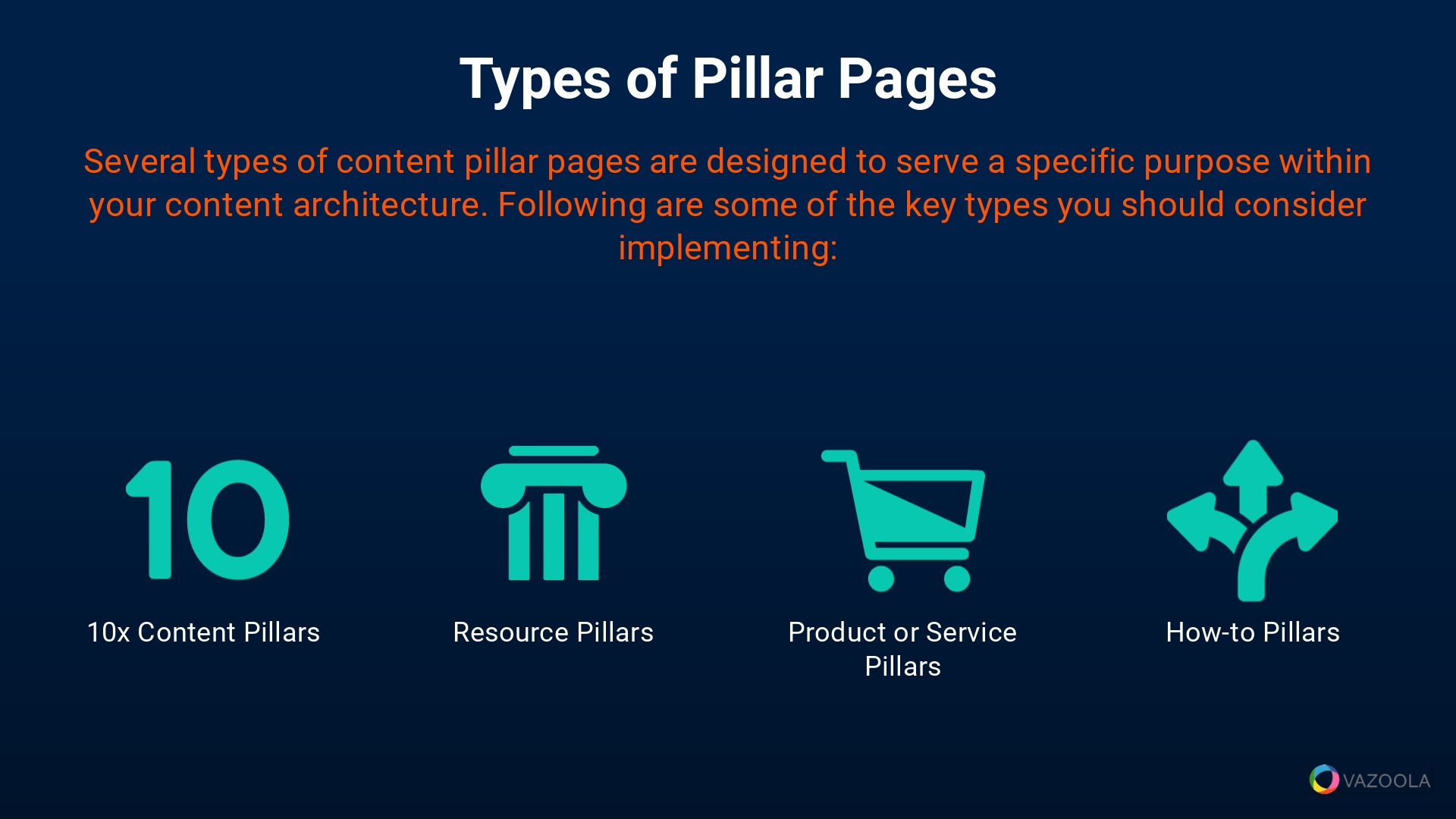
At Vazoola, we recognize the importance of diversifying your content strategy so it caters to an array of user needs and search intents.
Content pillar pages form the backbone of this strategy. They organize your content into distinct, manageable topics that are beneficial to your audience and optimized for search engines.
Several types of content pillar pages are designed to serve a specific purpose within your content architecture. Following are some of the key types you should consider implementing:
-
10x Content Pillars: These pillar pages are designed to be 10 times better than any other content currently available on the same topic. They cover a topic comprehensively, and they provide exceptional value and insight that stands out in the industry. For example, a definitive guide on email marketing best practices might include templates, strategies, case studies, and expert insights not found elsewhere.
-
Resource Pillars: Resource pillars aggregate a variety of resources and backlinks on a specific topic. The compilation serves as a one-stop-shop for all related information. These pillar pages are particularly useful for topics that involve numerous subtopics or external references. A resource pillar for startup funding, for instance, could link to grant opportunities, investor directories, pitch advice, and financial planning tools.
-
Product or Service Pillars: Focused on a company’s offerings, product and service SEO pillars detail the features, benefits, and applications of a product or service. They also link to case studies, user guides, and testimonial pages. A software company, for example, might have a product pillar page for their project management tool, linking to usage scenarios, integration options, and customer success stories.
-
How-To Pillars: How-To pillars are instructional pillar pages that provide step-by-step guides on specific processes or tasks. They are designed to be practical and user-friendly, while offering clear, actionable information. A how-to pillar on how to set up a home office could include sections on selecting the right furniture, tech setup, and productivity tips.
Pro Tips:
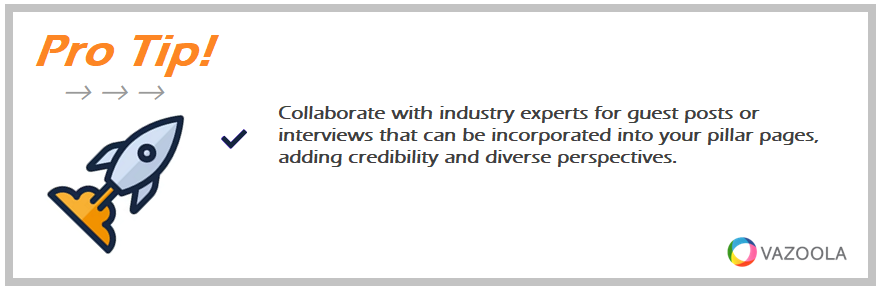
Collaborate with industry experts for guest posts or interviews that can be incorporated into your pillar pages, adding credibility and diverse perspectives.
Best Pillar Page Examples
When it comes to SEO and content strategy, a standout pillar page dramatically enhances your website's visibility and user engagement.
Looking for real-world examples of excellent pillar pages that effectively employ the content pillar strategy? Consider the following examples that showcase diverse approaches across different industries.
Typeform's Brand Awareness Guide
Typeform hosts an exceptional pillar page that serves as a comprehensive guide on brand awareness. The page is designed to be a go-to resource, and it covers all aspects of the topic. It also links to related content, which establishes authority and improves SEO.
Ahrefs' SEO Guide
Ahrefs’ pillar page, “SEO: The Complete Guide for Beginners,” is a high-level introduction to SEO. It branches out into detailed guides about various aspects of SEO, forming a complete content hub. The structure boosts SEO, and it simplifies user navigation to related topics.
Semrush's Content Marketing Toolkit
Semrush’s pillar page about their Content Marketing Toolkit provides a deep dive into content marketing tools and strategies. It’s an example of how a pillar page can be both informational and a gateway to the tool itself. The page directly links the educational content with practical application.
Topic Clusters and Pillar Page Best Practices
When you begin creating pillar pages and topic clusters, it's important to align your efforts with best practices, so you maximize the efficacy of your content strategy, as well as your more specific link building strategy.
How many pillar pages should you have?
The right number of pillar pages largely depends on the breadth of your brand’s expertise and the diversity of topics relevant to your audience.
As a good rule of thumb, make sure about 10-20% of your content creation efforts are directed towards developing pillar pages. This limited saturation ensures a solid foundation of core topics, each supported by more detailed blog posts and articles in associated clusters.
How does a pillar article benefit SEO?
Pillar articles significantly enhance SEO by organizing your content into a more manageable and navigable structure for search engines. They link extensively to and from related cluster content, which helps distribute page authority across your site more.
Such interlinking tells search engines that your pillar page is a comprehensive and authoritative source on the topic. This recognition then can improve your rankings for specific keywords.
Pro Tips:
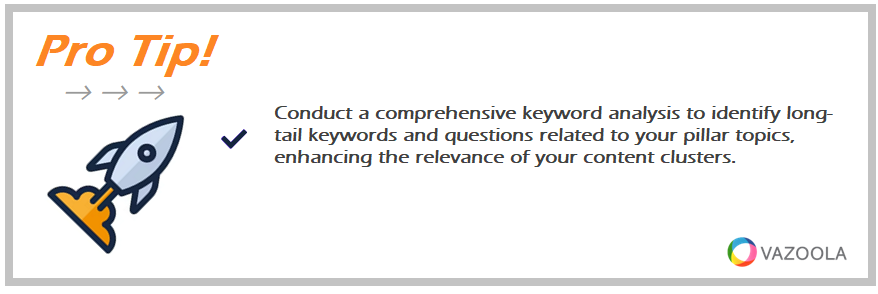
Conduct a comprehensive keyword analysis to identify long-tail keywords and questions related to your pillar topics, enhancing the relevance of your content clusters.
Who should produce pillar content?
Pillar content is beneficial across a variety of businesses and industries. E-commerce platforms, B2B companies, and even small businesses can leverage pillar content to establish thought leadership and improve SEO.
The key is to focus on topics central to the brand’s identity and value proposition. This way, you make sure the content is relevant and valuable to the target audience.
How can you do pillar content with limited resources?
Creating effective pillar content doesn’t necessarily require extensive resources or professional graphic design. While high-quality visuals can enhance the appeal of your content, the priority should be on the depth and quality of the provided information.
Businesses with limited resources can focus on writing comprehensive, well-researched, text-based content that thoroughly covers the topic. Over time, as resources allow, you can incrementally improve the design and interactivity of the pillar pages.
Pro Tips:
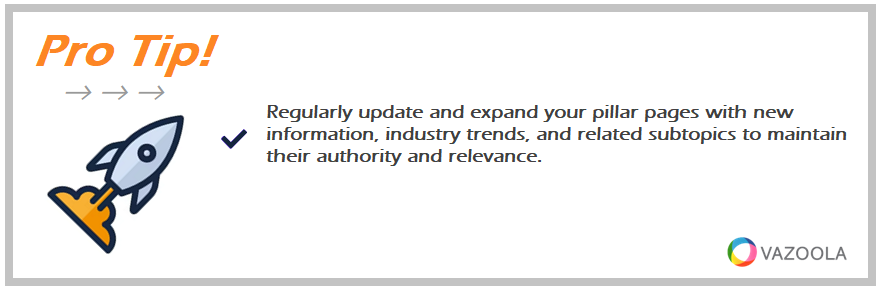
Regularly update and expand your pillar pages with new information, industry trends, and related subtopics to maintain their authority and relevance.

